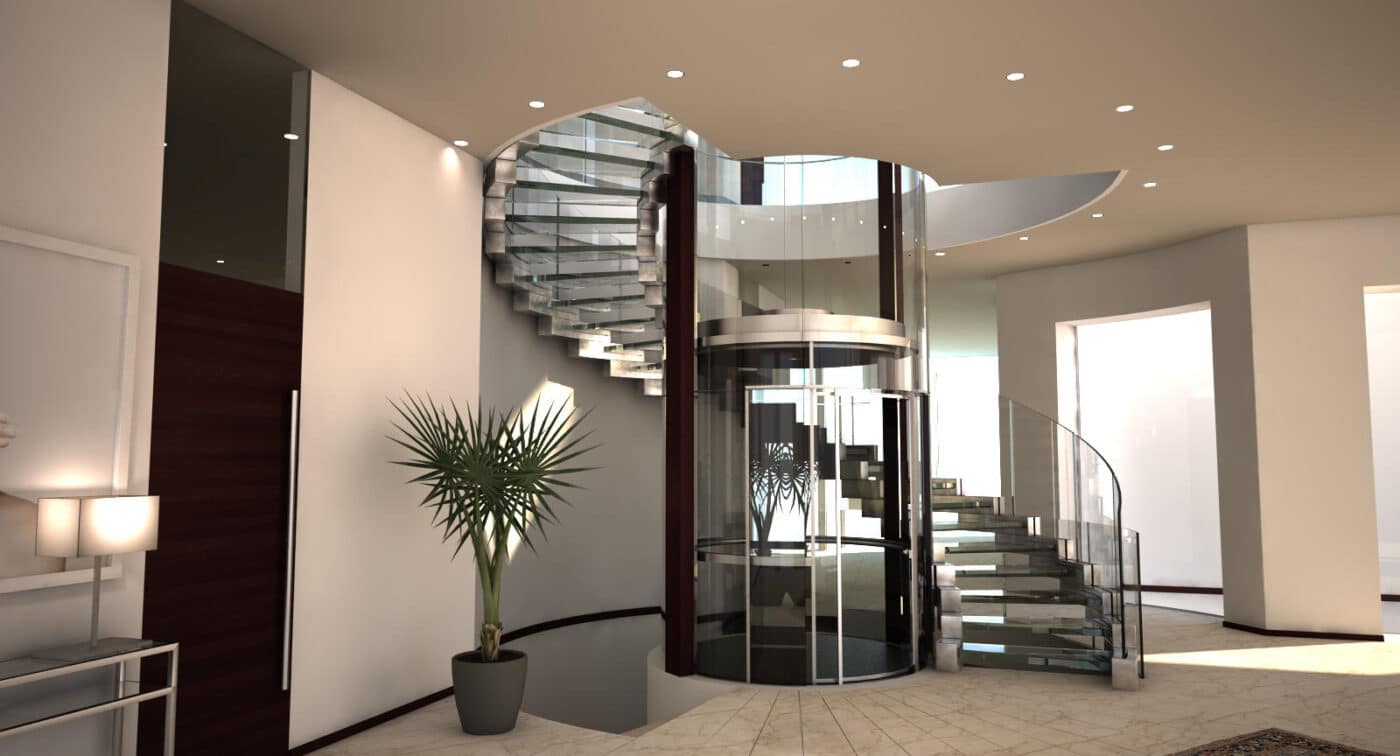
Elevators are primarily found in commercial spaces like malls and hospitals but are now common in modern homes. With many homeowners in India prioritizing convenience and accessibility, the difference between commercial and residential lifts has become increasingly significant.
Are you wondering what sets home elevators apart from their commercial counterparts? You’re about to find out. These two elevators are designed to meet different needs and comply with specific regulations, creating notable differences in functionality and purpose. Let’s take a closer look at how they compare.
The Evolution of Elevators: From Commercial to Residential Use
Shifting Trends in Elevator Usage
Elevators were once primarily associated with large commercial buildings and public spaces. However, this perception has changed significantly as more homeowners now choose to install stylish and comfortable elevators in their residences. This trend is fueled by the demand for greater convenience and a desire to elevate living standards.
Safety and Compliance Standards
In India, where elevator regulations are not always consistently enforced, setting a high standard for safety is essential. Residential lifts stand out by adhering to strict European safety certifications. It ensures top-notch safety, reliability, and performance, providing homeowners with peace of mind and addressing any concerns about quality.
What Are Commercial Elevators?
Commercial elevators are designed for buildings that serve more than just a single-family residence. Examples include apartment complexes, office buildings, retail stores, and industrial facilities.
These elevators must meet specific size and weight requirements to accommodate more users simultaneously. As a result, they are typically larger than residential elevators.
While commercial elevators are more expensive to install and maintain, their construction often includes durable steel frames, making them highly reliable and long-lasting. However, this added durability involves a more complex and costly installation process.
What are Residential Elevators?
Residential lifts are explicitly designed for private homes and are generally more affordable to install and maintain than commercial elevators. This cost advantage often comes from timber frame construction, which is less expensive than the steel frames used in commercial models.
Unlike commercial elevators, residential elevators are not bound by strict size and weight requirements. They are typically smaller, with maximum weight capacities ranging from 500 to 750 pounds.
Although residential elevators are not always required to meet ADA standards for wheelchair accessibility, many models are designed to accommodate wheelchairs and other mobility aids, making them a convenient option for enhancing accessibility in homes.
Key Difference Between Commercial and Residential Elevators
Size and Weight Requirements
Home Lifts: Home elevators are compact and specifically designed to fit seamlessly into private residences, often without requiring major architectural modifications. Unlike commercial elevators, they are not subject to strict size and weight regulations. While smaller, many models are built to accommodate wheelchairs, ensuring accessibility for residents with mobility challenges.
Commercial Elevators: Commercial elevators are built to meet rigorous size and weight standards, as they are used in public spaces and high-traffic environments. These elevators are typically larger to handle more passengers and comply with government-mandated accessibility requirements. Their design prioritizes safety, durability, and efficiency, making them capable of managing heavy usage and higher capacities.
Safety Features and Regulations
Home Lifts: Home elevators have essential safety features like emergency brakes, alarm systems, and interlocks, ensuring reliable operation. While they adhere to European safety standards, residential elevator regulations are less stringent than commercial ones. Home elevators are designed for private use, with lower usage frequency and different risk factors. However, these tailored standards still prioritize safety without compromising reliability.
Commercial Elevators must meet stricter safety requirements due to their use in public and high-traffic areas. They must comply with local, state, and national codes, including government accessibility guidelines. These elevators have advanced safety features such as fire service operation, emergency lighting, and communication systems. Regular inspections and mandatory maintenance ensure they remain compliant and safe for all users, even under heavy usage.
Weight Capacity and Vertical Distance
Home Lifts: Home elevators are designed with a smaller weight capacity, typically around 500 kg, which is more than enough for typical household needs like carrying passengers, groceries, or luggage. These elevators also have a limited vertical travel distance, usually serving up to four or five floors, making them ideal for multi-story homes but unsuitable for taller buildings.
Commercial Elevators: Commercial elevators are built to support much larger weight capacities, often reaching up to 5000 kg. It enables them to transport large groups of passengers, heavy equipment, and goods efficiently. With the ability to travel greater vertical distances—sometimes up to 300 meters and across multiple stops—commercial elevators are designed for use in office buildings, hotels, and other multi-story commercial spaces. They are built to handle constant use and heavy traffic with ease.
Installation and Maintenance
Home Lifts: Installing a home elevator is generally less disruptive than installing a commercial elevator. Since home elevators don’t require major structural changes or large machine rooms, the installation process is more straightforward. These elevators often feature compact machinery that can be seamlessly integrated into existing spaces with minimal disruption. Maintenance is usually simple and can typically be handled by the homeowner or a local service provider.
Commercial Elevators: Installing commercial elevators requires careful planning and significant structural adjustments. They often need machine rooms and strong support systems to ensure safe and efficient operation. Maintaining commercial elevators is more complex, requiring a professional team to conduct regular inspections, repairs, and updates. This ongoing attention ensures the elevator complies with safety standards and performs reliably in busy, high-traffic environments.
Choosing the Right Elevator for Your Home
Choosing between a commercial and a residential elevator goes beyond functionality. It involves prioritizing safety, ease of use, and creating a smooth and comfortable experience for everyone in your home or business. SWIFT Lifts’ commitment to quality, safety certifications, and innovative technology makes them the ideal choice for homeowners looking to enhance their living spaces with reliable and efficient home elevator solutions.
For those considering installing an elevator in their home, we offer unparalleled expertise and a range of options tailored to your needs. Elevate your home with us and experience the difference in quality and comfort today.
Conclusion
Commercial elevators are built to handle high-traffic, public environments. They must meet strict safety standards and are designed for large capacity and frequent use, making them ideal for office buildings, hotels, and shopping complexes. These elevators are larger, more robust, and can cover greater distances.
On the other hand, residential lifts, such as SWIFT Lite and SWIFT Pro, are specifically designed for homes. SWIFT Lite is perfect for homeowners looking for a compact and cost-effective solution, while SWIFT Pro offers enhanced features and higher capacity for larger homes or those requiring more frequent use. Both options prioritize accessibility, safety, and convenience and are designed to integrate smoothly into your living space without significant modifications.
When deciding between a commercial elevator and a residential lift, think about the space, usage frequency, and your specific needs. If you’re looking for a reliable, efficient, high-quality lift solution, SWIFT Lifts offers options that fit every requirement. Contact us today to discover which lift option best suits your space and elevate your home quickly and comfortably!
FAQs
Residential elevators are designed for lower capacity and private use, so they typically don’t meet the high demands of a commercial space. Commercial elevators are built for heavier traffic and larger capacities.
Both include emergency brakes, interlocks, and alarms. Due to higher traffic and public use, commercial elevators have added safety features like fire service operation, emergency lighting, and communication systems.
Residential elevators require more straightforward maintenance, often handled by local service providers. Due to their higher usage and strict regulations, commercial elevators need regular, more complex inspections and professional maintenance.
Residential elevators are easier to install with fewer structural changes. Commercial elevators require more planning, larger machine rooms, and reinforced structures for heavy use.
Consider the capacity and usage—commercial elevators handle more traffic and heavier loads. Also, evaluate space, cost, and safety requirements. Residential elevators are more compact and affordable, while commercial lifts need more space and are pricier to maintain.
Get in Touch










